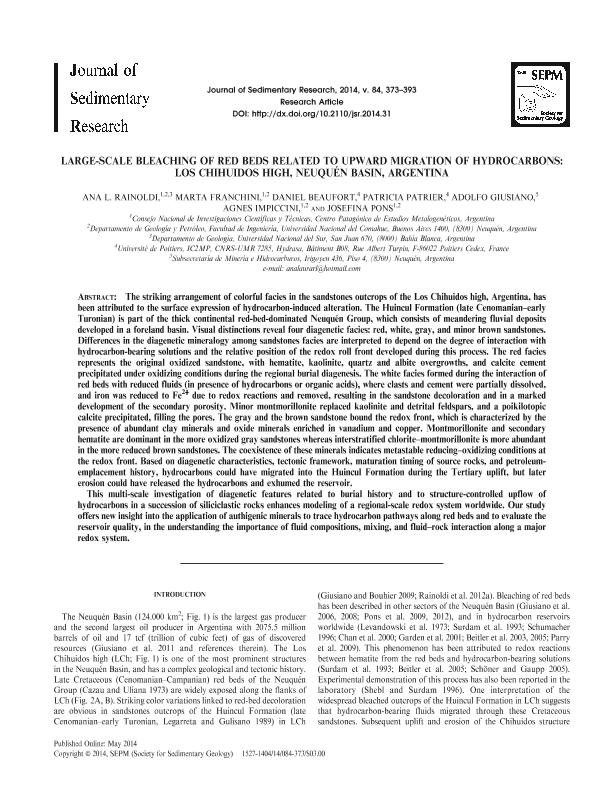Artículo
Large-Scale Bleaching of Red Beds Related To Upward Migration of Hydrocarbons: Los Chihuidos High, Neuquén Basin, Argentina
Rainoldi, Ana Laura ; Franchini, Marta Beatriz
; Franchini, Marta Beatriz ; Beaufort, Daniel; Patrier, Patricia; Giusiano, Adolfo Eugenio; Impiccini, Agnes; Pons, María Josefina
; Beaufort, Daniel; Patrier, Patricia; Giusiano, Adolfo Eugenio; Impiccini, Agnes; Pons, María Josefina
 ; Franchini, Marta Beatriz
; Franchini, Marta Beatriz ; Beaufort, Daniel; Patrier, Patricia; Giusiano, Adolfo Eugenio; Impiccini, Agnes; Pons, María Josefina
; Beaufort, Daniel; Patrier, Patricia; Giusiano, Adolfo Eugenio; Impiccini, Agnes; Pons, María Josefina
Fecha de publicación:
05/2014
Editorial:
Society for Sedimentary Geology
Revista:
Journal of Sedimentary Research - (Print)
ISSN:
1527-1404
Idioma:
Inglés
Tipo de recurso:
Artículo publicado
Clasificación temática:
Resumen
The striking arrangement of colorful facies in the sandstones outcrops of the Los Chihuidos high, Argentina, has been attributed to the surface expression of hydrocarbon-induced alteration. The Huincul Formation (late Cenomanian–early Turonian) is part of the thick continental red-bed-dominated Neuquén Group, which consists of meandering fluvial deposits developed in a foreland basin. Visual distinctions reveal four diagenetic facies: red, white, gray, and minor brown sandstones. Differences in the diagenetic mineralogy among sandstones facies are interpreted to depend on the degree of interaction with hydrocarbon-bearing solutions and the relative position of the redox roll front developed during this process. The red facies represents the original oxidized sandstone, with hematite, kaolinite, quartz and albite overgrowths, and calcite cement precipitated under oxidizing conditions during the regional burial diagenesis. The white facies formed during the interaction of red beds with reduced fluids (in presence of hydrocarbons or organic acids), where clasts and cement were partially dissolved, and iron was reduced to Fe2+ due to redox reactions and removed, resulting in the sandstone decoloration and in a marked development of the secondary porosity. Minor montmorillonite replaced kaolinite and detrital feldspars, and a poikilotopic calcite precipitated, filling the pores. The gray and the brown sandstone bound the redox front, which is characterized by the presence of abundant clay minerals and oxide minerals enriched in vanadium and copper. Montmorillonite and secondary hematite are dominant in the more oxidized gray sandstones whereas interstratified chlorite–montmorillonite is more abundant in the more reduced brown sandstones. The coexistence of these minerals indicates metastable reducing–oxidizing conditions at the redox front. Based on diagenetic characteristics, tectonic framework, maturation timing of source rocks, and petroleum-emplacement history, hydrocarbons could have migrated into the Huincul Formation during the Tertiary uplift, but later erosion could have released the hydrocarbons and exhumed the reservoir. This multi-scale investigation of diagenetic features related to burial history and to structure-controlled upflow of hydrocarbons in a succession of siliciclastic rocks enhances modeling of a regional-scale redox system worldwide. Our study offers new insight into the application of authigenic minerals to trace hydrocarbon pathways along red beds and to evaluate the reservoir quality, in the understanding the importance of fluid compositions, mixing, and fluid–rock interaction along a major redox system.
Palabras clave:
Diagenetic
,
Facies
,
Hydrocarbon
,
Induced-Alteration
,
Bleaching
,
Redox
,
Roll
,
Front
,
Uplift
Archivos asociados
Licencia
Identificadores
Colecciones
Articulos(CCT - PATAGONIA NORTE)
Articulos de CTRO.CIENTIFICO TECNOL.CONICET - PATAGONIA NORTE
Articulos de CTRO.CIENTIFICO TECNOL.CONICET - PATAGONIA NORTE
Citación
Rainoldi, Ana Laura; Franchini, Marta Beatriz; Beaufort, Daniel; Patrier, Patricia; Giusiano, Adolfo Eugenio; et al.; Large-Scale Bleaching of Red Beds Related To Upward Migration of Hydrocarbons: Los Chihuidos High, Neuquén Basin, Argentina; Society for Sedimentary Geology; Journal of Sedimentary Research - (Print); 84; 5; 5-2014; 373-393
Compartir
Altmétricas



